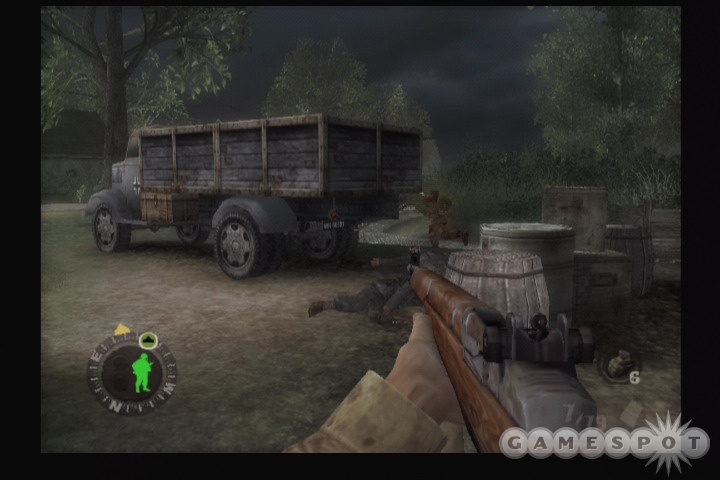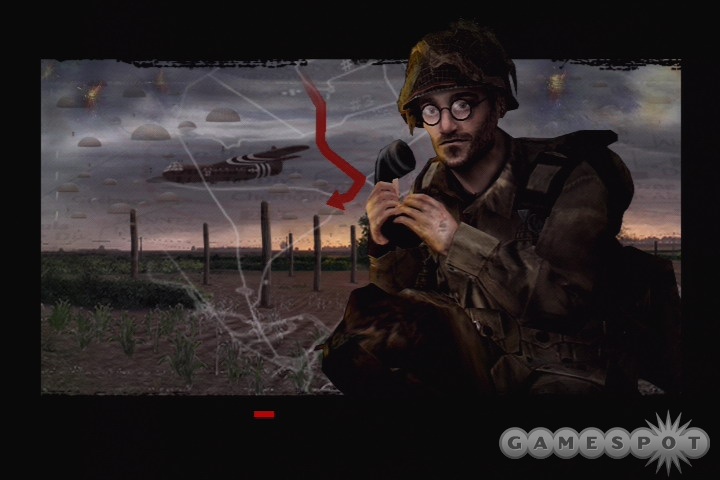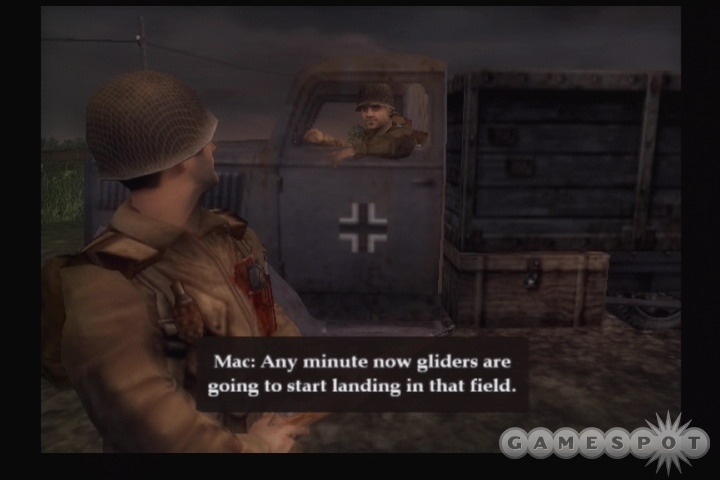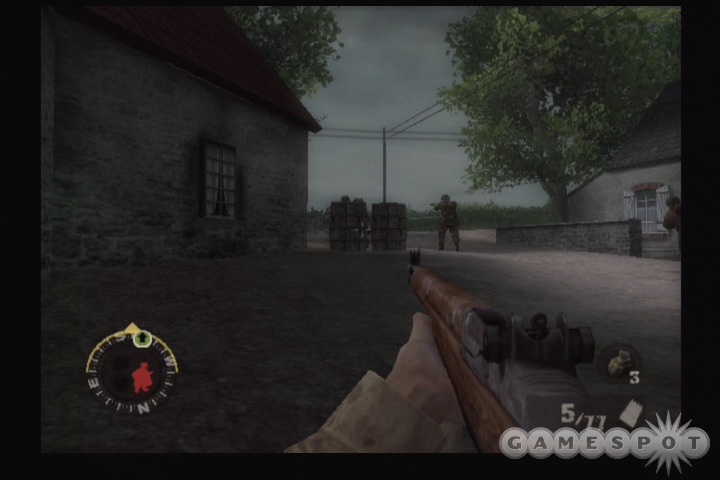We'll admit it. When we first heard about Brothers in Arms: Road to Hill 30, a small voice inside our heads said cynically, "Just what the world needs...another World War II-based first-person shooter." Sure, it has some squad command mechanics, but it wasn't lost on us that those design aspects were rather similar to another military game, Full Spectrum Warrior. Brothers in Arms differs in that it puts a gun in your hands and actually lets you pull the trigger. The game is paced more deliberately than other popular WWII shooters, such as Medal of Honor and Call of Duty, but it still offers a great deal of intensity and realism in its battles. The multiplayer aspect maintains the squad command mechanics of the single-player game and gives it a fresh and unique feel. Despite all these factors going for it, the PlayStation 2 version of Brothers in Arms doesn't quite measure up to the PC and Xbox versions. The game feels noticeably unpolished across the board, with muddier graphics, tinny sound effects, and, most egregiously, problems with the game balance.

Brothers in Arms puts you in the role of Sgt. Matt Baker, a real-life member of the 101st Airborne Division. The game's 17-chapter campaign stretches over a week's time. You'll start out the night before D-Day, when you and the rest of the division parachute behind enemy lines into France, fighting your way into and capturing the town of Carentan. Each chapter and all the settings are based closely on actual missions carried out by Baker's platoon. As you beat each mission, you'll unlock extras, such as photographs and reconnaissance photos, which show you how closely the game's levels match what Baker's platoon fought through in the critical first days of the invasion.
The game's presentation attempts to be cinematic, borrowing cues from popular World War II fare such as Band of Brothers. Every chapter begins with a simple screen and title in stark white letters, narrated somberly by Baker's character. You'll also watch some in-engine cutscenes before and after missions that not only summarize the previous mission in the context of the war, but also get you personally acquainted with the rest of your squadmates. These presentational aspects set the mood of the game well, but unfortunately can't be skipped. There is one thing that breaks the mood of the game, and that's when squadmates who die in the course of your gameplay all of a sudden appear fully healthy in the next mission. It's also worth noting that some of the dialogue has been stripped out of the PS2 version of the game, so certain scenes and conversations feel disjointed. Sloppy audio splicing exacerbates the problem.
The quiet, introspective thoughts that Baker and his squadmates share between missions are a stark contrast to the intense, chaotic battles you'll fight. The game's campaign offers an interesting mix of mission types. Some will have you assaulting small towns crawling with German infantry, machine gun nests, and snipers. You'll also explore hedgerows filled with hidden mortar teams and German 88mm guns, which are a menace to your tanks. Another chapter has you clearing obstacles off of heavily defended farms in order to make a path for gliders to land. You'll need to deal with enemy tanks on a couple of missions, and while you will often have access to a bazooka or your own armor under your command in these cases, it's often easier to sneak up behind the enemy tank, climb onto it, and drop a grenade into the hatch to take it out. You'll also be treated to shooting gallery-style missions later on, where you're defending a position while armed with a sniper rifle. The campaign should last most players more than 10 hours on their first play-through.
Depending on the mission, you'll command either one or two squad elements, each of which can consist of a few infantrymen or a tank. Infantry are either designated as an assault team or a fireteam. The former is usually armed with submachine guns and is better at charging and eliminating enemies, while the latter carry rifles and are better at establishing a base of fire on an enemy position for suppression. Like in Full Spectrum Warrior, you'll see icons over enemy positions to signify their condition. Fully suppressed enemies aren't supposed to move or fire much, and when they do shoot, their accuracy is poor. Unsuppressed enemies are supposed to be much more accurate with their shots and may actually move, either to get a better attack position or to find more-useful cover. At least, that's how it works in the Xbox and PC versions of Brothers in Arms. In the PS2 version of the game, suppressed enemies get a bead on you too quickly when you try to flank them. They also don't seem to lose much accuracy when they fire back at you, and sometimes they'll even charge at you instead of cowering in place as in the PC and Xbox versions. Overall, it feels as though the PS2 version of Brothers in Arms wasn't properly balanced, and some situations become difficult to manage because the game's central design element doesn't operate as intended.

At any rate, the design conceit gives you some incentive to actually use established army doctrine to find, fix, flank, and finish the enemy. One or two of your elements hold an enemy down with a base of fire, while you can move yourself or use another element to flank around the side to take that enemy out. Players who are more hands-on will obviously want to take the finishing aspect into their own hands, while more strategic-minded players still have the option of sending in a squad element to do the dirty work. It's also worth noting that, unlike in Full Spectrum Warrior, enemies behind cover are not invincible to direct fire. If you're a good shot with a rifle, you can still pick off an enemy who pokes his head a little too far out from behind cover. In the PS2 version of the game, the effect of cover is actually a lot less pronounced than in the PC and Xbox versions, both for enemies and for your own troops. This turns out to be a double-edged sword of sorts. While it can be easier to take out enemies without using flanking maneuvers, you'll find that your own troops or your own character get hit with enemy fire when they should be protected. It's rather frustrating that your teammates often die from just two hits in the PS2 version of the game, unlike in the more forgiving Xbox and PC versions. Again, this calls the game balancing into question, as the missions in the PS2 version of the game are noticeably more frustrating.
To help you with the job of maneuvering, Brothers in Arms includes a mode called "situational awareness." It's basically a pause state that zooms out and gives you an overhead view of the map with limited rotation and zoom ability. From here you can examine your own position and the position of your squad elements relative to that of known enemy positions. This mode is extremely helpful, as it allows you to make more intelligent decisions about maneuvering and positioning. You can only see enemy contacts that you've already made, so you can't cheat to see what else might be lying in wait up ahead. However, it's still possible to use the situational awareness mode to confirm the number of enemies behind cover, so there is some advantage to always peeking at this screen every time you find a new contact.
The command interface in Brothers in Arms is fairly streamlined. By pressing the L1 button, you'll get a command ring, which you can then move around the landscape to command your selected squad element to move. The squad artificial intelligence is fairly clever. If they know they're moving into the line of fire, they'll fire at the enemy position while proceeding in a low and fast manner. They'll also stack up behind any nearby cover and automatically fire at any enemy that comes into sight. You can order them to intensify their fire on a position for suppression or call for an all-out charge. While the streamlined command interface keeps things simple, it can be frustrating at times in the uncommon cases when your soldiers don't get behind cover properly or take a strange path to their target. You also don't have the ability to specifically call for a grenade toss, although they will throw grenades on their own from time to time.

As far as controlling your own character, Brothers in Arms offers a couple of twists from your standard shooter. You can move about (albeit a bit more slowly than in most shooters) and toggle between standing and kneeling positions, which expectantly affects your accuracy. You'll notice this most with the Springfield sniper rifle, as the scope drift is dramatically lessened while kneeling. What's different about Brothers in Arms is that the default setting does not give you a crosshair with which to aim. If you choose to fire from the hip, you're pretty much guessing where your shots will land. In effect, you are forced to toggle the zoom, which lets you aim your gun along the iron sight in order to shoot with any degree of accuracy. Your movement speed is also cut down to a fraction while aiming, so if you want to fire while on the move, you need to make a choice between movement speed and shot accuracy. This adds to the game's realism and feels less contrived compared to other games that simply expand your crosshair reticle as you run.
You'll use an array of different weapons, including M1 Garands, Thompson submachine guns, BARs, and fixed machine guns. You'll also pick up antitank weapons, such as bazookas, and you can loot weapons off of dead enemies. In general, you're probably better off sticking with the guns you start each mission with until you start running into the elite German Fallschirmjager, who carry the Sturmgewehr automatic assault rifle. Grenades are very limited in the game. You don't get them in every mission, and you can't seem to loot any off of corpses. It's also fairly tricky to toss them; learning how to arc them just right will take some practice. Just be careful to pay attention to your tosses. If you don't suppress an enemy position before throwing a grenade, you're liable to get that pineapple tossed right back in your face.
Unlike many other games of this type, multiplayer Brothers in Arms isn't just an afterthought. The multiplayer aspect retains the squad command aspects from the single-player campaign, resulting in a game that plays in a fairly unique style. Matches can be set up for two to four players online on any of 10 objective-based maps. Most of these maps will involve demolitions of some sort, with one side attempting to plant a bomb on a strategic target, such as a bomb or antiaircraft gun, while the other side tries to prevent the bomb from exploding over a fixed period of time. Each player in the game controls one or two squad elements, and you can also hop out to situational awareness mode to check your surroundings, although the game does not pause in this mode during multiplayer matches. If the soldier you're controlling goes down, you can immediately take control of another member of that squad element. Get your whole element wiped out, and you'll need to respawn at your original spawn point with a fresh element.
The overall feel of multiplayer Brothers in Arms is much more strategic than a typical shooter. There's a lot of depth involved with coordinating attacks with your teammates, such as trying to confuse the enemy with feints or linking up on one side of the map for an all-out charge. Raw skill at first-person shooters certainly helps, but aiming skill alone doesn't quite compensate for a player who utilizes his squad commands to the fullest. That aspect gives Brothers in Arms a unique style, and one which should give the game lasting appeal for multiplayer. In our testing, the online play had wildly varying performance. Some games, usually the two-player ones, worked fine, while others had severe latency issues, even on those servers that reported decent or good pings. For those stuck offline, split-screen play is available for up to two players, but being able to see your opponent's position takes much of the mystery and strategy out of the matches.
The graphics and sound in the PS2 version of Brothers in Arms, like the overall gameplay, don't quite measure up to the other two versions. Character models are good for a PS2 game and offer up some decent amount of detail in their motions, such as the way they carry their weapons and take position behind cover. The models do appear a bit blocky at times, however, and the character faces have a somewhat lifeless, mannequin-like quality to them, particularly in the eyes. Terrain and surface textures also lack detail, but the vehicles and weapon models look realistic. Bullets kick up debris and dust depending on their impact point. In fact, if you're being fired upon, you'll see bits of dirt kick up and "stick" to the screen as the bullets plink and whiz by your head. Your squadmates will also yell for you to get down. These are useful visual and audio cues that alert you to when you should duck your head back behind cover. On the downside, the gunshot sounds in the PS2 version of the game are less sharp and impactful than in the Xbox and PC versions, and in many cases, they don't sound nearly as realistic.

You'll see noticeable blood spray as you fire at and hit enemies up close, but this isn't done gratuitously. There's also a fair amount of cussing, which, combined with the graphic nature of the game's battles, captures the grim reality of war (which is also found in any movie or miniseries). What's also interesting is that there's no music at all during gameplay. This seems like a conscious design decision, adding to the cold overall feeling that the game offers.
The PlayStation 2 version of Brothers in Arms attempts to bring together the best aspects of squad-based shooters and the freedom of a more action-oriented game. The campaign is varied and lengthy enough to keep you interested from beginning to end. While the result is still a game that offers a unique and overall enjoyable feel, the lack of polish in the gameplay design detracts from what should have been a truly great experience. Considering the minimized impact of using defilade and the inconsistencies in the enemy AI, playing the PS2 version of Brothers in Arms is often much more frustrating and difficult than it should be, especially when compared to the Xbox and PC versions of the game. The compromises in presentation also make the game's story come across much less cinematic than intended. In effect, the PS2 version of Brothers in Arms seems like a game that could have used a bit more time in production.